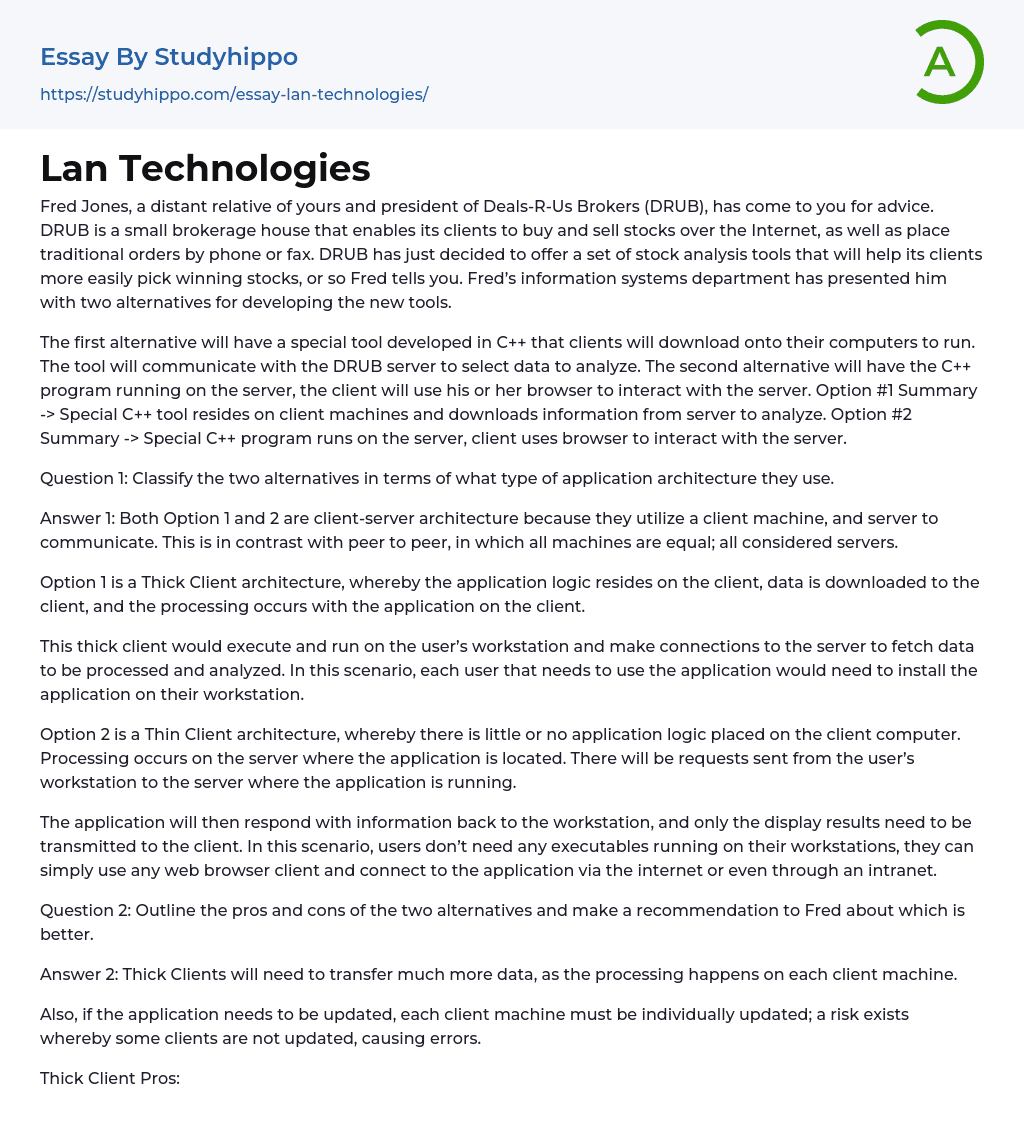Fred Jones, who is a distant relative of yours, is seeking your advice. He is the president of Deals-R-Us Brokers (DRUB), a small brokerage house that offers online stock trading options to its clients, along with the ability to place traditional orders via phone or fax.
DRUB has made a decision to provide clients with stock analysis tools, according to what Fred has told you. The information systems department has presented Fred with two options for creating the new tools. The first option involves developing a special tool in C++ that clients can download onto their computers. This tool will communicate with the DRUB server in order to select and analyze data. Alternatively, the second option involves running the C++ program on the server, with clients using their browsers to interact with the server.
Option #1 Summary -> A special C++ too
...l is stored on client machines and is used to download information from the server for analysis. Option #2 Summary -> A special C++ program runs on the server, and clients interact with the server using a browser.
Question 1: Classify the two alternatives based on their application architecture.
Answer 1: Both Option 1 and 2 utilize a client-server architecture, as they involve a client machine and a server for communication. This is different from peer to peer architecture, where all machines are considered equal and function as servers.
Option 1 is based on a Thick Client architecture, where the application logic is stored on the client's workstation. The client downloads data and performs processing within the application. Users need to install the application on their workstation and connect to the server for retrieving data for analysis.
On
the other hand, Option 2 utilizes a Thin Client architecture. In this scenario, there is little or no application logic installed on the client computer. Processing occurs on the server where the application is located. The user's workstation sends requests to this server for running the application.
The application will respond with information to the workstation, and only the display results need to be transmitted to the client. Users can connect via a web browser client over the internet or intranet without needing any executables on their workstations.
Question 2: Provide pros and cons of the two alternatives and recommend a better option to Fred.
Answer 2: Thick Clients require transferring larger amounts of data since processing occurs on each client machine.
When using a Thick Client, there are advantages and disadvantages. The benefits include improved application performance and a simpler development and implementation process. However, there is a disadvantage in that the application must be installed on every workstation and each workstation needs individual updates, which can be time-consuming. Tracking version control may also be challenging, and the application can face disruptions if users delete or modify its files. Furthermore, changes in the operating system may cause functional issues, requiring updates for different operating systems (32 bits, 64 bits). The update process for customers can also be time-consuming.
In contrast, Thin Clients are easier to manage because updates or changes only need to occur once on the server, granting all clients access to them. New clients simply require access permissions and the web address to use them. However, since Thin Clients rely on the client's browser, programming is necessary to ensure compatibility with popular browsers like Firefox,
Chrome, and Internet Explorer.
The advantages of utilizing a Thin Client include the ability for users to access the application from any supported browser via an intranet or the internet, easier implementation of application updates, restricted access to application files, and manageable versioning. Additionally, it eliminates the need for an additional hard disk and allows for centralized server support.
However, there are also disadvantages to using a Thin Client such as potential security difficulties when accessing the application through the internet, slower performance, dependency on the server's availability, and possible impact on application functionality due to browser changes. Furthermore, increased demands on the server and corporate network can lead to slower performance.
Despite these drawbacks, we recommend employing the Thin Client approach with a Client-Server based architecture as it offers various benefits over Thick Client architecture. It improves manageability, enables efficient data transfer, and ensures consistency in the user experience. This allows users to work regardless of their location within their company or even while traveling internationally. Due to hosting the application on the server-side, updates, configuration, and maintenance will incur lower costs since they only need to be done in one central location without repetition.
The distribution of the application can be expedited by simply setting up server-side access, which enables any user to access it. Additionally, the application can be configured with a failover server to minimize downtime and operational disruptions in case of an unexpected server failure.
- Email essays
- Hypertext Transfer Protocol essays
- Marshall Mcluhan essays
- Virtual Learning Environment essays
- Web Search essays
- Etiquette essays
- Mainstream essays
- Vodafone essays
- Web Search Engine essays
- Android essays
- Application Software essays
- Benchmark essays
- Computer Network essays
- Computer Programming essays
- Computer Security essays
- Computer Software essays
- Cryptography essays
- Data collection essays
- Data Mining essays
- Graphic Design essays
- Information Systems essays
- Internet essays
- Network Security essays
- Website essays
- World Wide Web essays
- Auction essays
- Balanced Scorecard essays
- Battle essays
- Business Plans essays
- Expense essays
- Income essays
- Intranet essays
- Maintenance essays
- Net Income essays
- Security Guard essays
- Simulation essays
- Singapore Airlines essays
- 12 Angry Men essays
- A beautiful mind essays
- A Separation essays
- Alfred Hitchcock essays
- American Beauty essays
- American Films essays
- Animation essays
- Avatar essays
- Blade Runner essays
- Bollywood essays
- Bond essays
- Bridge essays
- Cinema Of The United States essays




